EX-99.2
Published on April 17, 2013

The PNC
Financial Services Group, Inc. First Quarter 2013
Earnings Conference Call
April 17, 2013
Exhibit 99.2 |

2
Cautionary Statement Regarding Forward-Looking
Information and Adjusted Information
This
presentation
includes
snapshot
information
about
PNC
used
by
way
of
illustration.
It
is
not
intended
as
a
full
business
or
financial
review
and
should
be
viewed
in
the
context
of
all
of
the
information
made
available
by
PNC
in
its
SEC
filings.
The
presentation
also
contains
forward-looking
statements
regarding
our
outlook
for
earnings,
revenues,
expenses,
capital
levels
and
ratios,
liquidity
levels,
asset
levels,
asset
quality,
financial
position,
and
other
matters
regarding
or
affecting
PNC
and
its
future
business
and
operations.
Forward-looking
statements
are
necessarily
subject
to
numerous
assumptions,
risks
and
uncertainties,
which
change
over
time.
The
forward-looking
statements
in
this
presentation
are
qualified
by
the
factors
affecting
forward-looking
statements
identified
in
the
more
detailed
Cautionary
Statement
included
in
the
Appendix,
which
is
included
in
the
version
of
the
presentation
materials
posted
on
our
corporate
website
at
www.pnc.com/investorevents
and
in
our
SEC
filings.
We
provide
greater
detail
regarding
these
as
well
as
other
factors
in
our
2012
Form
10-K,
including
in
the
Risk
Factors
and
Risk
Management
sections
and
in
the
Legal
Proceedings
and
Commitments
and
Guarantees
Notes
of
the
Notes
To
Consolidated
Financial
Statements
in
that
report,
and
in
our
subsequent
SEC
filings.
Our
forward-looking
statements
may
also
be
subject
to
other
risks
and
uncertainties,
including
those
we
may
discuss
in
this
presentation
or
in
SEC
filings,
accessible
on
the
SECs
website
at
www.sec.gov
and
on
PNCs
corporate
website
at
www.pnc.com/secfilings.
We
have
included
web
addresses
in
this
presentation
as
inactive
textual
references
only.
Information
on
these
websites
is
not
part
of
this
presentation.
Future
events
or
circumstances
may
change
our
outlook
and
may
also
affect
the
nature
of
the
assumptions,
risks
and
uncertainties
to
which
our
forward-looking
statements
are
subject.
Forward-looking
statements
in
this
presentation
speak
only
as
of
the
date
of
this
presentation.
We
do
not
assume
any
duty
and
do
not
undertake
to
update
those
statements.
Actual
results
or
future
events
could
differ,
possibly
materially,
from
those
anticipated
in
forward-looking
statements,
as
well
as
from
historical
performance.
In
this
presentation,
we
may
sometimes
refer
to
adjusted
results
to
help
illustrate
the
impact
of
certain
types
of
items,
such
as
provisions
for
residential
mortgage
repurchase
obligations,
gains
on
sales
of
a
portion
of
our
VISA
shares,
non-cash
charges
related
to
redemptions
of
trust
preferred
securities,
expenses
for
residential
mortgage
foreclosure-related
matters,
goodwill
impairment
charge
and
integration
costs.
This
information
supplements
our
results
as
reported
in
accordance
with
GAAP
and
should
not
be
viewed
in
isolation
from,
or
as
a
substitute
for,
our
GAAP
results.
We
believe
that
this
additional
information
and
the
reconciliations
we
provide
may
be
useful
to
investors,
analysts,
regulators
and
others
to
help
evaluate
the
impact
of
these
respective
items
on
our
operations.
We
may
also
provide
information
on
the
components
of
net
interest
income
(purchase
accounting
accretion
and
the
core
remainder)
and
the
impact
of
purchase
accounting
accretion
on
net
interest
margin.
We
believe
that
core
net
interest
margin
(net
interest
margin
less
(annualized
purchase
accounting
accretion
divided
by
average
interest-earning
assets)),
a
non-GAAP
measure,
is
useful
as
a
tool
to
help
evaluate
the
impact
of
purchase
accounting
accretion
on
net
interest
margin.
Where
applicable,
we
provide
GAAP
reconciliations
for
such
additional
information,
including
in
the
slides,
the
Appendix
and/or
other
slides
and
materials
on
our
corporate
website
at
www.pnc.com/investorevents
and
in
our
SEC
filings.
In
certain
discussions,
we
may
also
provide
information
on
yields
and
margins
for
all
interest-earning
assets
calculated
using
net
interest
income
on
a
taxable-equivalent
basis
by
increasing
the
interest
income
earned
on
tax-exempt
assets
to
make
it
fully
equivalent
to
interest
income
earned
on
taxable
investments.
We
believe
this
adjustment
may
be
useful
when
comparing
yields
and
margins
for
all
earning
assets.
We
may
also
use
annualized,
proforma,
estimated
or
third
party
numbers
for
illustrative
or
comparative
purposes
only.
These
may
not
reflect
actual
results.
This
presentation
may
also
include
discussion
of
other
non-GAAP
financial
measures,
which,
to
the
extent
not
so
qualified
therein
or
in
the
Appendix,
is
qualified
by
GAAP
reconciliation
information
available
on
our
corporate
website
at
www.pnc.com
under
About
PNCInvestor
Relations. |

3
1Q13 Highlights
PNC Is Well-Positioned to Continue to Create Shareholder Value.
Strong financial performance in challenging
environment
Good progress on strategic priorities |
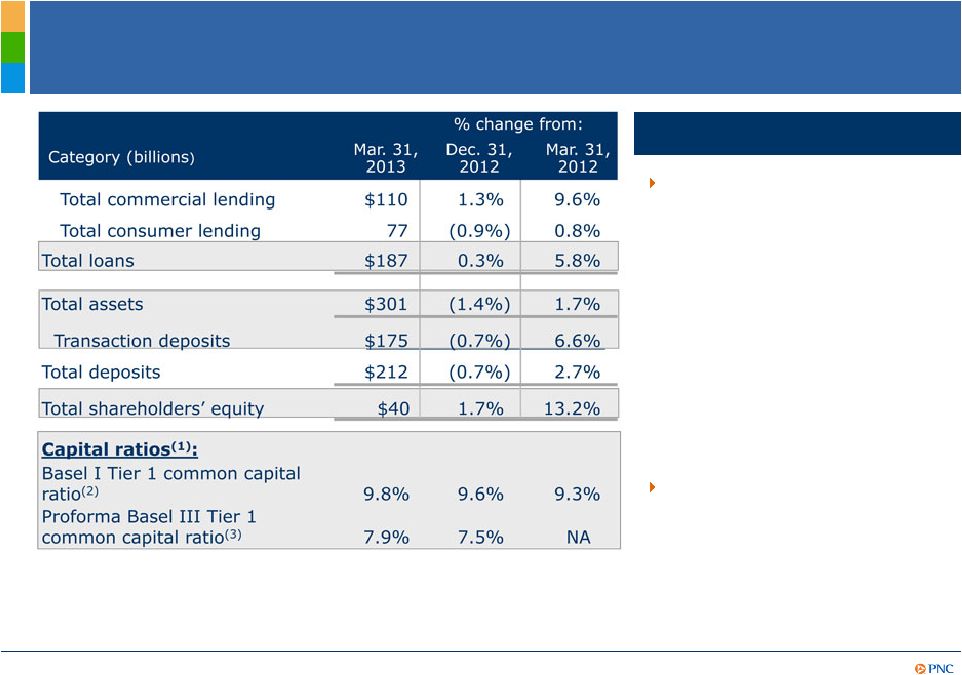
4
Loan and Deposit Trends Ease While Capital Ratios
Continue to Improve
Continued growth in customers
and loans, although at a slower
pace
Closing the gap towards Basel III
Tier 1 common capital operating
goal
(4)
(1)
Estimated at March 31, 2013. (2)
See Note 1 in the Appendix for further details. (3) PNCs proforma Basel III
Tier 1 common capital ratio was estimated without the benefit of phase-
ins and is based on our current understanding of Basel III proposed rules. See Note
2 in the Appendix for further details. Proforma Basel III Tier 1 common capital
ratio
estimate
not
provided
in
1Q12.
(4)
Basel
III
Tier
1
common
capital
operating
range
of
8.0%
-
8.5%
by
year-end
2013
subject
to
the
same
assumptions
described
in the preceding note.
Highlights
Loans increased $.7 billion from
December 31, 2012, primarily
driven by commercial lending of
$1.4 billion or 1.3% as a result of
specialty lending businesses
Consumer lending declined $.7
billion primarily due to pay downs
of residential real estate, credit
card and education loans
Average transaction deposits
grew $3.1 billion linked quarter |

5
Pretax Pre-Provision
Earnings
(1)
Growth Driving
Profitability and Returns
Highlights
Solid revenue and disciplined
expense management
Pretax pre-provision
earnings
(1)
increased 26%
linked quarter and 22% over
prior year
Credit costs met expectations
ROAA and ROACE increased
to 1.34% and 10.68%,
respectively
(millions)
1Q13
4Q12
1Q12
Net interest income
$2,389
$2,424
$2,291
Noninterest income
1,566
1,645
1,441
Total revenue
$3,955
$4,069
$3,732
Noninterest expense
($2,395)
($2,829)
($2,455)
Pretax pre-provision
earnings
(1)
$1,560
$1,240
$1,277
Provision
(236)
(318)
(185)
Pre-tax earnings
(2)
1,324
922
1,092
Net income
$1,004
$719
$811
Returns
ROAA
(3)
1.34%
.95%
1.16%
ROACE
(3)
10.68%
7.48%
9.41%
(1),(2),(3) See Notes 3, 4 and 5 respectively in the Appendix for additional details.
|
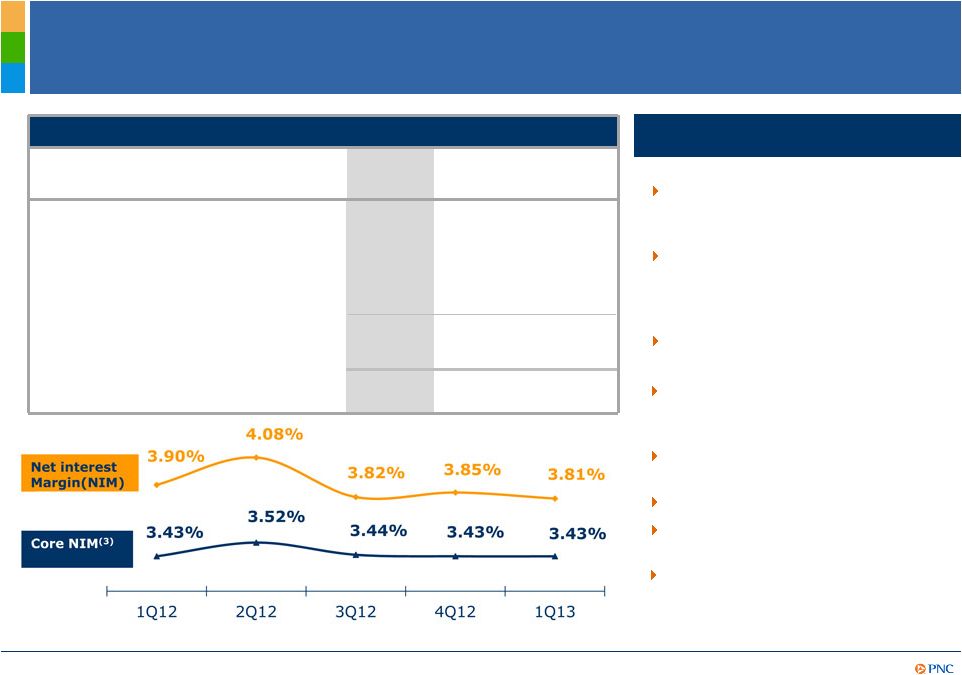
6
Modest Declines in Net Interest Income and NIM
(1)
Core
net
interest
income
(Core
NII)
is
total
net
interest
income
(NII),
as
reported,
less
related
purchase
accounting
accretion
(scheduled
and
excess
cash
recoveries).
(2)
See
Note
6
in
Appendix
for
further
details.
(3)
Net
interest
margin
less
(annualized
PAA/average
interest-earning
assets).
See
Reconcilement
in
Appendix.
(4)
Refer
to
Cautionary
Statement
in
the
Appendix,
including
economic
and
other
assumptions.
Core NII
(1)
$2,140
$2,151
$2,028
Scheduled accretion
199
228
223
Excess cash recoveries
(2)
50
45
40
Total purchase accounting
accretion (PAA)
249
273
263
Total NII
$2,389
$2,424
$2,291
Highlights
Linked quarter:
Prior year quarter:
1% increase in average interest-
earning assets driven by average
loan growth of $2.9 billion or 1.6%
NII declined less than 2% due to
lower scheduled PAA as Core NII
(1)
and excess cash recoveries
remained stable
Core NIM stable
8% increase in average interest-
earning assets driven by average
loan growth of $21.5 billion or 13%
Core NII
(1)
increased 6% primarily
due to loan growth
PAA declined $14 million or 5%
Core NIM stable
Expect NII to decline
approximately 2%-3% when
compared with 1Q13 primarily due
to decline in PAA
Second Quarter 2013 Outlook
(4)
:
(billions)
1Q13
4Q12
1Q12
Average interest-earning assets
$256
$254
$238
(millions) |
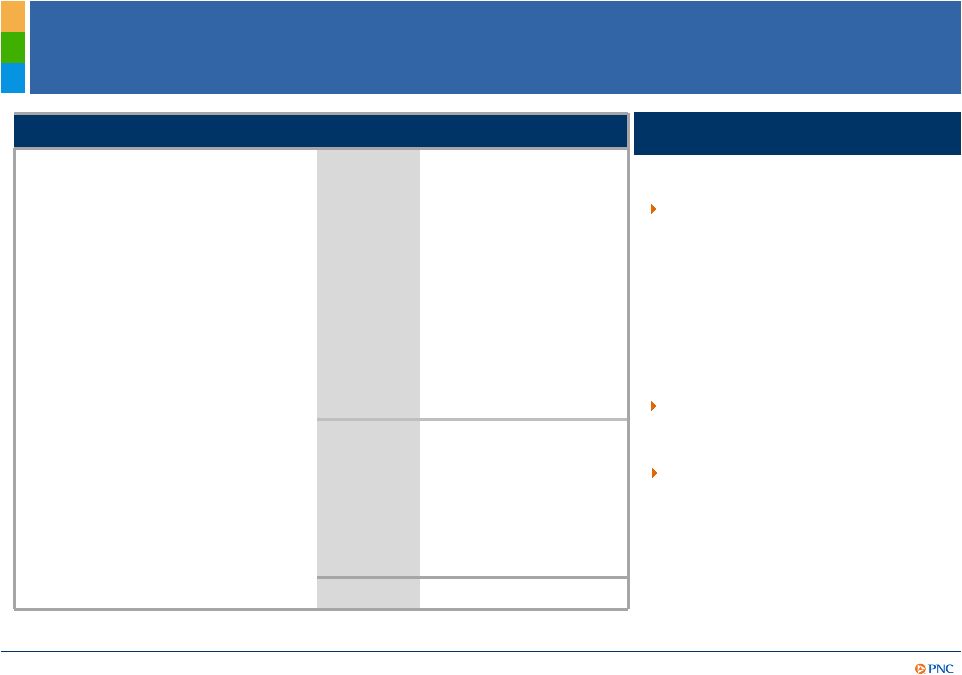
7
Diversified Businesses Delivered Solid Noninterest
Income
Highlights
(1) Asset management includes the Asset Management Group and BlackRock.
Noninterest income decreased 5%
Noninterest income to total
revenue remained steady at 40%
Linked quarter:
(millions)
1Q13
4Q12
1Q12
Asset management
(1)
$308
$302
$284
Consumer services
296
294
264
Corporate services
277
349
232
Residential mortgage
Residential mortgage banking
238
254
262
Provision for residential
mortgage repurchase
obligations
(4)
(254)
(32)
Deposit service charges
136
150
127
Fee income
$1,251
$1,095
$1,137
Net gains on sales of securities
less net OTTI
4
30
19
Gain on VISA sale
-
130
-
Other
311
390
285
Total noninterest income
$1,566
$1,645
$1,441
Prior Year Quarter:
Noninterest income increased 9%
primarily driven by strong fee
income growth in Asset
Management and Consumer,
Corporate and Deposit Services
Lower asset valuations and
sales, including sale of VISA
shares, and Corporate
Services fees
Partially offset by lower
provision for residential
mortgage repurchase
obligations |
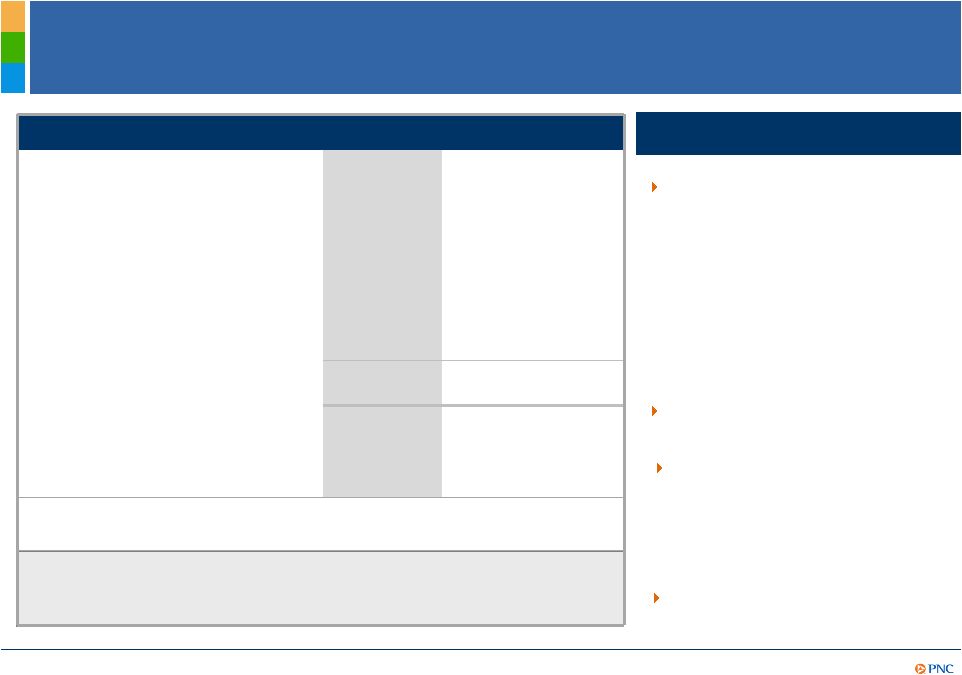
8
Disciplined Expense Management While Investing for
Growth
(millions)
1Q13
4Q12
1Q12
Adjusted for select items
(1)
:
Personnel
$1,169
$1,210
$1,067
Occupancy
211
210
178
Equipment
183
193
168
Marketing
45
64
54
Other
772
911
805
Noninterest expense, adjusted
for select items
$2,380
$2,588
$2,272
Select items
(1)
15
241
183
Total noninterest expense
$2,395
$2,829
$2,455
Efficiency ratio
(4)
61%
70%
66%
Efficiency ratio, adjusted
(4,5)
61%
67%
62%
Noninterest expense decreased
$434 million or 15% due to:
$700 million CIP
(2)
target remains
on track
Highlights
Linked quarter:
(1)
Select
items
are
residential
mortgage
foreclosure-related
matters,
trust
preferred
securities
redemption-related
charges,
goodwill
impairment
charges,
and integration
costs.
See
Reconcilement
section
of
the
Appendix
for
impact
of
each
select
item
on
each
category
of
noninterest
expense.
(2)
CIP
refers
to
PNCs Continuous
Improvement
Program.
(3)
Refer
to
Cautionary
Statement
in
the
Appendix,
including
economic
and
other
assumptions.
Does
not
take
into
account the
impact
of
potential
legal
and
regulatory
contingencies.
(4)
See
Note
7
in
the
Appendix.
(5)
Efficiency
ratio
adjusted
for
integration
costs
and
trust
preferred securities
redemption-related
charges
in
4Q12
and
1Q12.
See
Reconciliation
section
of
the
Appendix.
Prior Year Quarter:
Noninterest expense decrease of
2% reflects prior year integration
costs and the benefit of our CIP
efforts offset by overall business
investments, including RBC Bank
(USA)
Second Quarter 2013 Outlook
(3)
:
Expect noninterest expense to increase
2%-3% compared with 1Q13
Lower residential mortgage
foreclosure-related charges
No trust preferred securities
redemption charges, integration
costs or goodwill impairment
charges
Lower marketing expense and
reduced incentive compensation
costs primarily due to lower
capital markets activities |
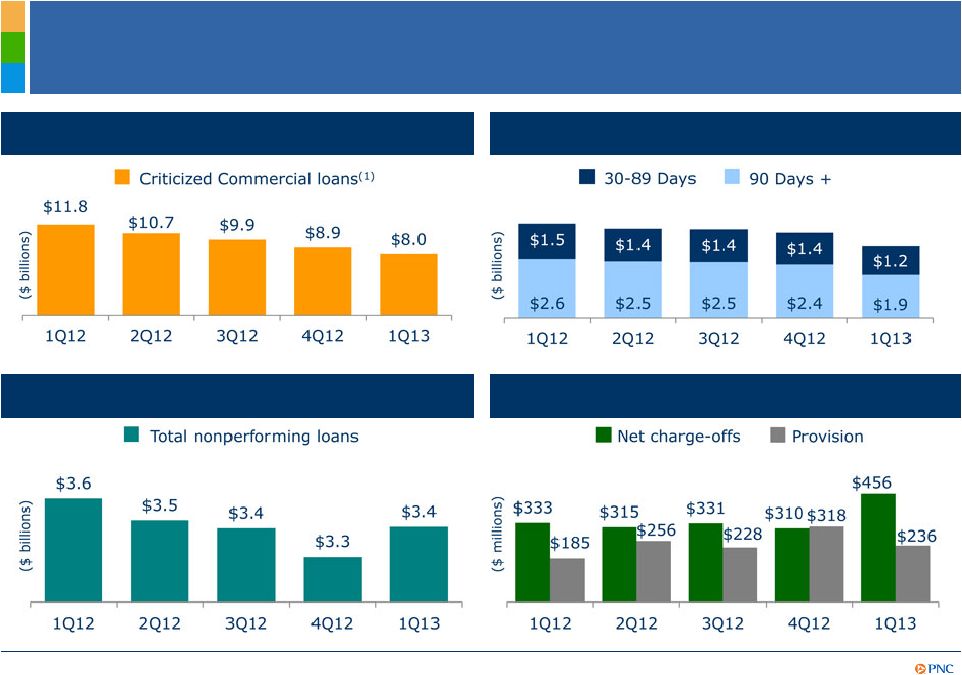
9
Underlying Credit Trends Continue to Improve
Nonperforming loans
(2,4)
Provision and net charge-offs
Criticized commercial loans
Accruing loans past due
(2,3)
As
of
quarter
end
except
net
charge-offs
and
provision,
which
are
for
the
quarter.
(1)
Criticized
loans
are
ones
that
we
consider
special
mention,
substandard
or
doubtful.
(2)
Loans
acquired
from
National
City
or
RBC
Bank
(USA)
that
were
impaired
are
not
included
as
they
were
recorded
at
estimated
fair
value
when
acquired
and
are
currently
considered
performing
loans
due
to
the
accretion
of
interest
in
purchase
accounting.
(3)
Includes
loans
that
are
government
guaranteed/insured,
primarily
residential
mortgages.
These
loans
totaled
$2.2
billion
in
1Q13.
(4)
Does
not
include
loans
held
for
sale
or
foreclosed
and
other
assets.
Excludes
certain
government
insured
or
guaranteed
loans
and
loans
accounted
for
under
the
fair
value
option. |

10
Key Takeaways
(1)
Strong financial performance
Certain quarterly trends may not be sustainable in current
environment
for 2Q13 expect:
Expect continued progress on achieving capital goal
(1)
Refer
to
Cautionary
Statement
in
the
Appendix,
including
economic
and
other
assumptions.
Does
not
take
into
account
impact
of
potential
legal
and
regulatory
contingencies.
Net income of $1 billion and EPS of $1.76
Modest spot loan growth
NII decline of approximately 2-3%
Expenses to increase approximately 2-3%
Provision of $200-$300 million |

11
Cautionary Statement Regarding Forward-Looking
Information
Appendix
This
presentation
includes
snapshot
information
about
PNC
used
by
way
of
illustration
and
is
not
intended
as
a
full
business
or
financial
review.
It
should
not
be
viewed
in
isolation
but
rather
in
the
context
of
all
of
the
information
made
available
by
PNC
in
its
SEC
filings.
We
also
make
statements
in
this
presentation,
and
we
may
from
time
to
time
make
other
statements,
regarding
our
outlook
for
earnings,
revenues,
expenses,
capital
levels
and
ratios,
liquidity
levels,
asset
levels,
asset
quality,
financial
position,
and
other
matters
regarding
or
affecting
PNC
and
its
future
business
and
operations
that
are
forward-looking
statements
within
the
meaning
of
the
PrivateSecurities
Litigation
Reform
Act.
Forward-looking
statements
are
typically
identified
by
words
such
as
believe,
plan,
expect,
anticipate,
see,
look,
intend,
outlook,
project,
forecast,
estimate,
goal,
will,
should
and
other
similar
words
and
expressions.
Forward-
looking
statements
are
subject
to
numerous
assumptions,
risks
and
uncertainties,
which
change
over
time.
Forward-looking
statements
speak
only
as
of
the
date
made.
We
do
not
assume
any
duty
and
do
not
undertake
to
update
forward-looking
statements.
Actual
results
or
future
events
could
differ,
possibly
materially,
from
those
anticipated
in
forward-looking
statements,
as
well
as from historical performance.
Our
forward-looking
statements
are
subject
to
the
following
principal
risks
and
uncertainties.
Our
businesses,
financial
results
and
balance
sheet
values
are
affected
by
business
and
economic
conditions,
including
the
following:
Changes
in
interest
rates
and
valuations
in
debt,
equity
and
other
financial
markets.
Disruptions
in
the
liquidity
and
other
functioning
of
U.S.
and
global
financial
markets.
The
impact
on
financial
markets
and
the
economy
of
any
changes
in
the
credit
ratings
of
U.S.
Treasury
obligations
and
other
U.S.
government-backed
debt,
as
well
as
issues
surrounding
the
level
of
U.S.
and
European
government
debt
and
concerns
regarding
the
creditworthiness
of
certain
sovereign
governments,
supranationals
and
financial
institutions
in
Europe.
Actions
by
Federal
Reserve,
U.S.
Treasury
and
other
government
agencies,
including
those
that
impact
money
supply
and
market
interest rates.
Changes
in
customers,
suppliers
and
other
counterparties
performance
and
creditworthiness.
Slowing
or
failure
of
the
current
moderate
economic
expansion.
Continued
effects
of
aftermath
of
recessionary
conditions
and
uneven
spread
of
positive
impacts
of
recovery
on
the
economy
and
our
counterparties,
including
adverse
impacts
on
levels
of
unemployment,
loan
utilization
rates,
delinquencies,
defaults
and
counterparty
ability
to
meet
credit
and
other
obligations.
Changes
in
customer
preferences
and
behavior,
whether
due
to
changing
business
and
economic
conditions,
legislative
and
regulatory initiatives, or other factors.
Our
forward-looking
financial
statements
are
subject
to
the
risk
that
economic
and
financial
market
conditions
will
be
substantially
different
than
we
are
currently
expecting.
These
statements
are
based
on
our
current
view
that
the
moderate
economic
expansion
will
persist
and
interest
rates
will
remain
very
low
in
2013,
despite
drags
from
Federal
fiscal
restraint
and
a
European
recession.
These
forward-looking
statements
also
do
not,
unless
otherwise
indicated,
take
into
account
the
impact
of
potential
legal
and
regulatory
contingencies. |

12
Cautionary Statement Regarding Forward-Looking
Information (continued)
Appendix
PNCs
regulatory
capital
ratios
in
the
future
will
depend
on,
among
other
things,
the
companys
financial
performance,
the
scope
and
terms
of
final
capital
regulations
then
in
effect
(particularly
those
implementing
the
Basel
Capital
Accords),
and
management
actions
affecting
the
composition
of
PNCs
balance
sheet.
In
addition,
PNCs
ability
to
determine,
evaluate
and
forecast
regulatory
capital
ratios,
and
to
take
actions
(such
as
capital
distributions)
based
on
actual
or
forecasted
capital
ratios,
will
be
dependent
on
the
ongoing
development,
validation
and regulatory approval of related models.
Legal
and
regulatory
developments
could
have
an
impact
on
our
ability
to
operate
our
businesses,
financial
condition,
results
of
operations,
competitive
position,
reputation,
or
pursuit
of
attractive
acquisition
opportunities.
Reputational
impacts
could
affect
matters
such
as
business
generation
and
retention,
liquidity,
funding,
and
ability
to
attract
and
retain
management.
These
developments
could
include:
Changes
resulting
from
legislative
and
regulatory
reforms,
including
major
reform
of
the
regulatory
oversight
structure
of
the
financial
services
industry
and
changes
to
laws
and
regulations
involving
tax,
pension,
bankruptcy,
consumer
protection,
and
other
industry
aspects,
and
changes
in
accounting
policies
and
principles.
We
will
be
impacted
by
extensive
reforms
provided
for
in
the
Dodd-Frank
Wall
Street
Reform
and
Consumer
Protection
Act
(the
Dodd-Frank
Act)
and
otherwise
growing
out
of
the
recent
financial
crisis,
the
precise
nature,
extent
and
timing
of
which,
and
their
impact
on
us,
remains
uncertain.
Changes
to
regulations
governing
bank
capital
and
liquidity
standards,
including
due
to
the
Dodd-Frank
Act
and
to
Basel-related
initiatives.
Unfavorable
resolution
of
legal
proceedings
or
other
claims
and
regulatory
and
other
governmental
investigations
or
other
inquiries.
In
addition
to
matters
relating
to
PNCs
business
and
activities,
such
matters
may
include
proceedings,
claims,
investigations,
or
inquiries
relating
to
pre-acquisition
business
and
activities
of
acquired
companies,
such
as
National
City.
These
matters
may
result
in
monetary
judgments
or
settlements
or
other
remedies,
including
fines,
penalties,
restitution
or
alterations
in
our
business
practices,
and
in
additional
expenses
and
collateral
costs,
and
may
cause
reputational
harm
to
PNC.
Results
of
the
regulatory
examination
and
supervision
process,
including
our
failure
to
satisfy
requirements
of
agreements
with
governmental agencies.
Impact
on
business
and
operating
results
of
any
costs
associated
with
obtaining
rights
in
intellectual
property
claimed
by
others
and of adequacy of our intellectual property protection in general.
Business
and
operating
results
are
affected
by
our
ability
to
identify
and
effectively
manage
risks
inherent
in
our
businesses,
including,
where
appropriate,
through
effective
use
of
third-party
insurance,
derivatives,
and
capital
management
techniques,
and
to
meet
evolving
regulatory
capital
standards.
In
particular,
our
results
currently
depend
on
our
ability
to
manage
elevated
levels
of
impaired
assets.
Business
and
operating
results
also
include
impacts
relating
to
our
equity
interest
in
BlackRock,
Inc.
and
rely
to
a
significant
extent
on
information
provided
to
us
by
BlackRock.
Risks
and
uncertainties
that
could
affect
BlackRock
are
discussed
in
more
detail
by
BlackRock
in
its SEC filings. |

13
Cautionary Statement Regarding Forward-Looking
Information (continued)
Appendix
We
grow
our
business
in
part
by
acquiring
from
time
to
time
other
financial
services
companies,
financial
services
assets
and
related
deposits
and
other
liabilities.
Acquisition
risks
and
uncertainties
include
those
presented
by
the
nature
of
the
business
acquired,
including
in
some
cases
those
associated
with
our
entry
into
new
businesses
or
new
geographic
or
other
markets
and
risks
resulting
from
our
inexperience
in
those
new
areas,
as
well
as
risks
and
uncertainties
related
to
the
acquisition
transactions
themselves,
regulatory
issues,
and
the integration of the acquired businesses into PNC after closing.
Competition
can
have
an
impact
on
customer
acquisition,
growth
and
retention
and
on
credit
spreads
and
product
pricing,
which
can
affect
market
share,
deposits
and
revenues.
Industry
restructuring
in
the
current
environment
could
also
impact
our
business
and
financial
performance
through
changes
in
counterparty
creditworthiness
and
performance
and
in
the
competitive
and
regulatory
landscape.
Our
ability
to
anticipate
and
respond
to
technological
changes
can
also
impact
our
ability
to
respond
to
customer
needs
and
meet
competitive
demands.
Business
and
operating
results
can
also
be
affected
by
widespread
natural
and
other
disasters,
dislocations,
terrorist
activities
or
international
hostilities
through
impacts
on
the
economy
and
financial
markets
generally
or
on
us
or
our
counterparties
specifically.
We
provide
greater
detail
regarding
these
as
well
as
other
factors
in
our
2012
Form
10-K,
including
in
the
Risk
Factors
and
Risk
Management
sections
and
the
Legal
Proceedings
and
Commitments
and
Guarantees
Notes
of
the
Notes
To
Consolidated
Financial
Statements
in
that
report,
and
in
our
subsequent
SEC
filings.
Our
forward-looking
statements
may
also
be
subject
to
other
risks
and
uncertainties,
including
those
we
may
discuss
elsewhere
in
this
presentation
or
in
SEC
filings,
accessible
on
the
SECs
website
at
www.sec.gov
and
on
our
corporate
website
at
www.pnc.com/secfilings.
We
have
included
these
web
addresses
as
inactive
textual
references only. Information on these websites is not part of this document.
Any
annualized,
proforma,
estimated,
third
party
or
consensus
numbers
in
this
presentation
are
used
for
illustrative
or
comparative
purposes
only
and
may
not
reflect
actual
results.
Any
consensus
earnings
estimates
are
calculated
based
on
the
earnings
projections
made
by
analysts
who
cover
that
company.
The
analysts
opinions,
estimates
or
forecasts
(and
therefore
the
consensus
earnings
estimates)
are
theirs
alone,
are
not
those
of
PNC
or
its
management,
and
may
not
reflect
PNCs
or
other
companys
actual
or
anticipated
results. |

14
Notes
Appendix
Explanatory Notes
(1) Tier 1 common capital ratio is period-end Tier 1 common capital divided by
period-end risk weighted assets and is estimated for March 31, 2013.
(6) Excess cash recoveries reflect cash received in excess of recorded investment from sales
or payoffs of impaired commercial loans.
(4) Pretax earnings is defined as income from continuing operations before income taxes and
noncontrolling interests. (7) Efficiency ratio calculated as noninterest expense
divided by total revenue. (3) Pretax pre-provision earnings is defined as total
revenue less noninterest expense. We believe that pretax pre-provision earnings, a
non-GAAP measure, is a useful tool to help evaluate the ability to provide for credit costs through operations.
(5) ROAA is Return on Average Assets and ROACE is Return on Average Common Equity.
(2) PNC utilizes the estimated proforma Basel III Tier 1 common capital ratio to assess its
Basel III capital position, including comparison to similar estimates made by other
financial institutions. Tier 1 common capital as defined under the proposed Basel III
rules differs materially from Basel I. For example, under Basel III, unconsolidated
investments in financial institutions, mortgage servicing rights and deferred tax
assets above certain quantitative thresholds must be deducted from Tier 1 common capital. Risk-
weighted assets were estimated under Basel II (including the modifications proposed under
Basel III) and application of Basel II.5, and reflect credit, market and operational
risk. The estimate is based on PNC's understanding of these rules and is subject to
further regulatory clarity and the ongoing evolution, validation and regulatory approval of
PNC's models integral to the calculation of Basel II risk-weighted
assets. |

15
Non-GAAP to GAAP Reconcilement
Appendix
$ in millions
Mar. 31, 2013
Dec. 31, 2012
Sept. 30, 2012
Jun. 30, 2012
Mar. 31, 2012
Net interest margin, as reported
3.81%
3.85%
3.82%
4.08%
3.90%
Purchase accounting accretion (1)
$249
$273
$245
$343
$263
Purchase accounting accretion, if annualized
$1,010
$1,086
$975
$1,380
$1,058
Avg. interest earning assets
$256,180
$253,643
$252,606
$250,132
$237,734
Annualized purchase accounting accretion/Avg. interest earning assets
0.38%
0.42%
0.38%
0.56%
0.47%
Core net interest margin (2)
3.43%
3.43%
3.44%
3.52%
3.43%
(1) Puchase accounting accretion is scheduled purchase accounting accretion plus cash
recoveries. For the three months ended
(2) PNC believes that core net interest margin, a non-GAAP measure, is useful as a tool to
help evaluate the impact of purchase accounting accretion on net interest margin. The
adjustment represents annualized purchase accounting accretion divided by average interest-earning assets.
In millions
Mar. 31, 2013
Dec. 31, 2012
Mar. 31, 2012
Total revenue, as reported
$3,955
$4,069
$3,732
Total noninterest expense, as reported
$2,395
$2,829
$2,455
Efficiency ratio, as reported
61%
70%
66%
Total revenue, as reported
$3,955
$4,069
$3,732
Total noninterest expense, as reported
$2,395
$2,829
$2,455
Adjustments:
Integration costs
-
(35)
(145)
Total noninterest expense, as adjusted
$2,395
$2,724
$2,310
Efficiency ratio, as adjusted
61%
67%
62%
* Efficiency ratio calculated as noninterest expense divided by total revenue
-
For the three months ended
Noncash charges for unamortized discounts related to
redemption of trust preferred securities
-
(70) |

16
Non-GAAP to GAAP Reconcilement
Appendix
In millions
Mar. 31, 2013
Dec. 31, 2012
Mar. 31, 2012
Personnel, as reported
$1,169
$1,216
$1,111
Integration costs
6
44
Personnel, as adjusted
1,169
1,210
1,067
Occupancy, as reported
211
226
190
Integration costs
16
12
Occupancy, as adjusted
211
210
178
Equipment, as reported
183
194
175
Integration costs
1
7
Equipment, as adjusted
183
193
168
Marketing, as reported
45
70
68
Integration costs
6
14
Marketing, as adjusted
45
64
54
Other, as reported
787
1,123
911
Residential mortgage foreclosure-related matters
(15)
(91)
(38)
TPS redemption-related charges
-
(70)
-
Goodwill impairment charges
-
(45)
Integration costs
-
(6)
(68)
Other, as adjusted
772
911
805
Noninterest expense, adjusted for select items
$2,380
$2,588
$2,272
Select items - Total
15
241
183
Total noninterest expense
$2,395
$2,829
$2,455
For the quarter ended |